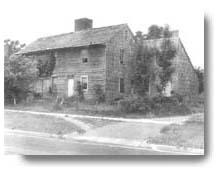Preserving Old East Hampton

The Thanksgiving holiday, already steeped in early American history and domestic life, will throw open several windows on how East Hampton's residents lived and continue to live.
As noted elsewhere in this section, the historic J. Harper Poor Cottage will be open to the public for the benefit of LTV, and the East Hampton Historical Society has arranged tours of contemporary and older mansions down Georgica Road, around the Maidstone Club, and through the dunes of Amagansett, from 1 to 4 p.m. Saturday.
In the meantime, East Hampton Village, whose officials are now happily ensconced in the historic Beecher-Hand House (also described separately today), has issued a newsletter with a wealth of interesting historical tidbits illustrated with a good number of photographs.
Hook District Houses
The lead story is about the recent creation of the Hook Historic District, the second of two historic districts in the village. It covers 50 properties around Hook Mill and part of North Main Street and Pantigo Road, including the 1715 Dayton-Stratton House, one of only four houses in East Hampton with the exposed carved framing typical of its period.
This story segues into a piece about the William Hedges house on North Main Street, one of the last remaining farmhouses from the agrarian East Hampton of the 1800s.
Barns, Outbuildings
Having been in the hands of the same family from 1828 until earlier this year, the house and attached farm buildings were like a living museum, with the original primitive washroom with old laundry tubs and a kitchen with a cooking fireplace. The 19th-century workshop was intact, with its workbench, pine flooring, and batten door with wrought iron hardware.
Another essay is devoted to the village's historic barns and outbuildings, including the early 18th-century Mulford Barn on James Lane and the icehouse at the Gardiner-Brown House, both of which have recently been restored.
A remarkable complex of buildings survives on the grounds of the James Madison Strong and John Young Strong houses in the Hook Historic District: a 19th-century barn, a granary, a milk house for storing and cooling milk, and a poultry house.
Dominy House
Now undergoing restoration in the program is the 1804 Gardiner Windmill on James Lane, an outstanding example of the millwrighting skills of Nathaniel Dominy 5th, of the famous Dominy woodworking family.
A historical footnote is the photograph of the original 1715 Dominy House, demolished in 1946. It stood on the present site of the North Main Street IGA parking lot.
Robert Hefner, who produced the newsletter, spoke of the village's preservation goals as being "an ongoing concern for preserving the whole fabric of the village."
The booklet, produced by the Design Review Board in connection with the Village Historic Preservation Program, will be mailed to all village householders and can also be found at Village Hall.
